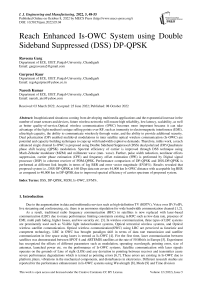Reach Enhanced Is-OWC System using Double Sideband Suppressed (DSS) DP-QPSK
Автор: Raveena Garg, Gurpreet Kaur, Naresh Kumar
Журнал: International Journal of Engineering and Manufacturing @ijem
Статья в выпуске: 5 vol.12, 2022 года.
Бесплатный доступ
Insophisticated situations coming from developing multimedia applications and the exponential increase in the number of smart sensors and devices, future wireless networks will ensure high reliability, low latency, scalability, as well as better quality-of-service.Optical wireless communication (OWC) becomes more important because it can take advantage of the light medium's unique selling points over RF, such as immunity to electromagnetic interference (EMI), ultra-high capacity, the ability to communicate wirelessly through water, and the ability to provide additional security. Dual polarization (DP) enabled multilevel modulations in inter satellite optical wireless communication (Is-OWC) are potential and capacity building techniques to cope up with bandwidth explosive demands. Therefore, inthis work, a reach enhanced single channel Is-OWC is proposed using Double Sideband Suppressed (DSS) dual polarized (DP) Quadrature phase shift keying (QPSK) modulation. Spectral efficiency of carrier is improved through DSS technique using Mach-Zehndar modulator (MZM) and millimeter wave (mm- wave). Further, pulse width reduction, nonlinear effects suppression, carrier phase estimation (CPE) and frequency offset estimation (FPE) is performed by Digital signal processor (DSP) in coherent receiver of PDM-QPSK. Performance comparison of DP-QPSK and DSS-DP-QPSK is performed at different link lengths in terms of log BER and error vector magnitude (EVM%). Results revealed that proposed system i.e., DSS-DP-QPSK at 160 Gbps data rate covers 44,000 km Is-OWC distance with acceptable log BER as compared to 40,000 km in DP-QPSK due to improved spectral efficiency of carrier spectrum of proposed system.
DSS, DP-QPSK, MZM, Is-OWC, EVM%.
Короткий адрес: https://sciup.org/15018593
IDR: 15018593 | DOI: 10.5815/ijem.2022.05.04
Текст научной статьи Reach Enhanced Is-OWC System using Double Sideband Suppressed (DSS) DP-QPSK
Due to the augmentation in data and multimedia services such as high-definition TV (HDTV), Voice over IP (VoIP), live streaming and conferencing, etc. there is an enormous stipulation for wide bandwidth communication channel [1,2].
As a result, traditional radio frequency communication (RFC) in satellites is now replaced with laser-based communication (LBC) due to many performance limiting constraints existing in RFC such as low data rate, presence of EMI, multi path fading, higher losses, and low security etc. [3]. In wireless communication, three types of LBC systems are prominently used such as Visible light indoor/outdoor systems, Optical terrestrial wireless systems, and Optical wireless satellite communication. Optical wireless communication(OWC) using LBC are perceived as futuristic and competent technology. LBC in OWC has brought paradigm shift in terms of data rate transmission and satellite communication in free space using lasers is termed as Is-OWC [4]. For the first time, laser communication between satellites was demonstrated between SPOT-4 and ARTEMIS satellites at the rate of 50 Mbit/s in Europe [5]. Experiment has recognized the effects of different parameters such as modulation, operating wavelength, pointing error, size of antennas, launched power etc. on the performance of Is-OWC systems. Satellite communication with laser signals operates on the grounds of Line of sight (LOS) and any deviation in pointing between receiver and transmitter cause severe performance degradations which is termed as pointing errors [6,7]. These errors are existing in Is-OWC due to platform jitters, vibrations in the mechanical components, and disturbances in electronics. Different research studies are reported for the performance enhancement in Is-OWC systems using Wavelength [8], Mode [9] and Time division multiplexing [10]. Also, different pulse shapes are also employed in Is-OWC systems to enhance the system performance.A high speed, link reach enhanced Is-OWC system can be achieved using DP-QPSK modulation due to its spectral efficiency of 2 bits/s/Hz/polarization with half symbol rate and same bit rate. In this work is to further improve the spectral efficiency of DP-QPSK carrier spectrum for better performance analysis and to increase the link distance between satellites is introduced. Sideband suppression in DP-QPSK carrier spectrum is performed by employing peak point biased Mach-Zehnder modulator (MZM) and millimetre frequency range (30 GHz- 300 GHz) radio frequency (RF) signal. Proposed system is investigated in terms of log BER and error vector magnitude percentage (EVMP) at varied link distances. Further, effects of the digital signal processing (DSP) in the receiver is analysed by considering and neglecting the module.
2. Literature Review
Mode division multiplexing, Orthogonal frequency division multiplexing and coherent detection at receiver side for long haul communication is introduced and analysis are done for 100 Gbps data rate at a link distance of 20,500 km [2]. Modulation methods such as Chirped RZ, AMI and DPSK is compared for different data rates and results shows high Q factor and better performance of AMI at 40Gbps than others [3]. Wavelength division multiplexing of 16 channels at a data rate of 20 Gbps is employed using polarization diversity and MDRZ modulation and analysis in terms of BER and Q factor is observed, polarization diversity is introduced to reduce interference and observe using eye diagram [4]. Wavelength division multiplexing of 16 channels at a data rate of 100 Gbps using modulation scheme DQPSK is introduced and a link distance of 25000 km is successfully achieved at an acceptable BER [7]. Performance analysis of Is-OWC system at a distance of 5000km between 2 satellites in low earth orbit for 16 transceiver system is observed [8]. WDM-TDM-DPSK Is-OWC system at different data rates of 10Gbps,20 Gbps and 40Gbps is proposed and successfully covered a distance of 2500 km with low SNR [9]. Different modulation scheme is compared and studied at different data rates, also to increase the capacity of proposed system mode division multiplexing is introduced and results shows that performance of DQPSK is better than DPSK and Manchester coding up to 40Gbps and quality of system decreases with increase in data rate [10]. Binary phase shift keying (BPSK) based Is-OWC link was proposed over 6,000 km at 5.6 Gbps in TerraSAR-X [11] and it was observed that more input power and wider antenna sizes can enhance the performance of satellite communication. Followed by BPSK, research was performed on the QPSK and researcher found that QPSK has capacity doubling properties. Therefore, in [12], QPSK enabled Is-OWC system was demonstrated on 100 Gbps for 9,532 km, 160 Gbps for 7,542 km, and 400 Gbps for 4,767 km. Other modulation formats were also investigated in Is-OWC such as Non return to zero (NRZ) in [13], and return to zero in [14], but they suffer from broad carrier spectrums reduced performance. Advanced modulation formats were also introduced and used in Is-OWC to offer narrow carrier spectrum advantages and knows as Compressed spectrum (CS) RZ [15]. CSRZ provide phase shift after each 50% duty cycle and offer tolerance against pulse width broadening effects. Improved version with better carrier spectral efficiency was introduced in Duo-binary RZ (DRZ) [16] and it has maximum ability to suppress the effects of nonlinearities and pulse width broadening. Modified DRZ (MDRZ) was also used in many research articles to get enhanced reach and performance. It provides phase shift between binary ones that are separated by odd number of binary zeros. In [17], author investigated a coherent optical QPSK Is-OWC system at different data rates and it was observed that system covered 23,000 km at 100 Gbps data speed. Single channel polarization multiplexed QPSK at 160 Gbps was proposed in [18] and covered 40,000 km link distance between two satellites.
The modulation format has a significant impact on the performance of any communication system, and OSSB is becoming a popular choice among academics due to its dispersion tolerance and low power fading effects. The carrier's spectrum efficiency is enhanced and performance is improved with the usage of OSSB [20]. In [21], optical double sideband (ODSB) and optical tandem sideband (OTDB) modulation in OFDM were compared, and the findings demonstrated that OSSB modulation performs well at high rates in Is-OWC systems. Author in [22] studied Is-OWC system with homodyne detection and double sideband suppressed carrier (DSB-SC) modulation and with improved receiver. In [23], Suppression of sidebands using Brillouin scattering in radio over fiber systems was demonstrated. In [24], researchersanalyze the performance of Is-OWC system between satellites in low earth orbiti.e., at a link distance varying from 1000 to 6000 km for different data rates of 10 Mbps to 10 Gbps using modulation On-Off Keying, it is also concluded that for high data rates such as 40 Gbps is achieved using QPSK modulation.In proposed work, a reach enhanced DP-QPSK based Is-OWC system is investigated using DSS technique at 160 Gbps. Spectral efficiency is improved and performance enhancement at receiver is performed using DSP. Comparison of DP-QPSK with and without DSS technique is also performed and it is observed that proposed system has 10% distance improvement.
Rest of paper is divided into sections as follows:
Section 3. discuss the basic theory and principle of proposed method, followed by system setup in Section 4. of proposed work. Experimental results and discussion . in Section 5. and concluding remarks are mention in Section 6.
3. Principle of DSS-DP-QPSK
In QPSK systems, a binary data stream is converted to a parallel data stream and four pairs of binary bits get different phase shifts such as 00 for 00, 900 for 01, 1800 for 10 and 2700 for 11. DP-QPSK modulation has increasingly attracted academic attention because of its two-fold spectral efficiency over QPSK and reduced interference due to varied polarization states. Each QPSK modulator gets a laser pulse from two polarization divided lasers and these polarizations are zero and 1800. For the aggregation of two different polarizations, the system includes a polarisation combiner. PDM-QPSK in mathematical form is represented in equation (1,2) [19]
Qdp-QPSK, X = QX(t) exp (j27rfct)exp[Pm,X(t)]
Qdp-QPSK, Y = QY(t) exp Ci27rfct)exp|Pm,Y(t)|
Where Qx (t) and Qy (t) are amplitude of X and Y polarizations, fcis carrier wave frequency, PmX, PmY are phases of electrical modulation signals for polarization X and Y respectively. Equation (3,4) represents output of X polarized signal is shown as
X, = R^2bL0Q(t) cos(2n(fc-fL0)t) + Pm,x(t) - Plo(O](3)
X q = R^2L Lo Q(t) Cos(2n(f c- f Lo )t) + P m,X( t) - P lo ( t)] (4)
Where in phase and Quadrature component electrical power X^X q respectively, Llo is input power of local oscillator, fL0 is local oscillator frequency and P LO is phase of oscillator and R is photo diode responsivity. Optical spectrum of PDM-QPSK has narrow spectrum but sidebands make it inefficient. Therefore, sideband suppression in proposed work is done with the maximum point biasing based Mach-zehndar modulator and radio frequency. RF frequency is 2 × bit rate, zero phase, zero bias, amplitude 2, 4V bias switching voltage and RF voltage LiNbO3 dual drive modulator as shown in Fig.2.
4. System Setup
Fig.1. represents the proposed DP-QPSK modulation transmitter in IsOWC system incorporating DSS technique. Binary speed of data from data generator is 160 Gbps and DP-QPSK transmitter provides polarization division multiplexing using signal laser at 850 nm. Input power of 30 dB is fixed from the laser and laser beam is divided into two signals using polarization beam splitter. Polarization X and Y are two components of split laser beam and data from binary data generator is also divided into two bit streams which are modulated over orthogonal polarization states using QPSK modulator. Further, modulated QPSK signals are combined with the incorporation of polarization beam combiner and sent to DSS generation module. DSS generation consists of a maximum biased MZM and a RF signal having frequency 320 GHz as shown in Fig.2. Output signal amplified using erbium doped fiber amplifier prior to transmitting in the outer space. An Is-OWC channel having 4,000 km link length in single loop is iterated to achieve longer distances and output signal then again amplified Fig.3.
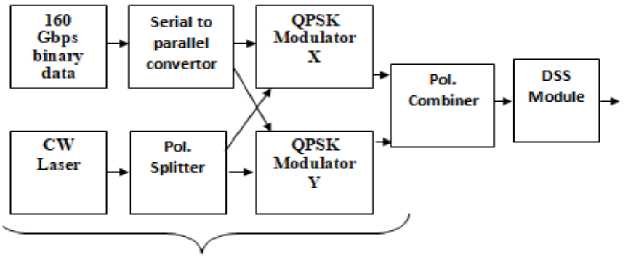
Fig.1. DSS-DP-QPSK Transmitter
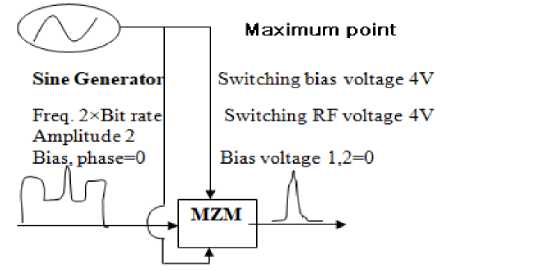
Fig.2. Proposed DSS generation module
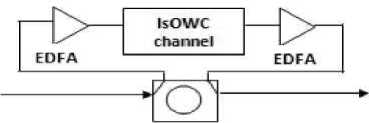
Fig. 3. Transmission channel
A DP-QPSK receiver as shown in Fig.4. is consisting of polarization beam splitter, a local oscillator of power 11 dB, a coherent receiver to extract IQ component, electrical amplifiers having Gain 20 dB, a low pass filter, for the compensation of nonlinear effects, FOE and COE, DSP is also employed.
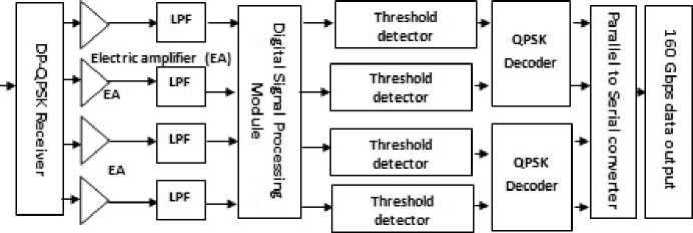
Fig.4. DP-QPSK Receiver
5. Experimental Results and Discussion
The system is evaluated and performed using Optisystem software and link distances of the Is-OWC was varied for the findings and analysis at 28000 km, 36000 km, 44000 km, 52000 km, 60000 km, and 68000 km., further results are investigated in terms of log BER, EVM% and received power for DP-QPSK and DSS-DP-QPSK.
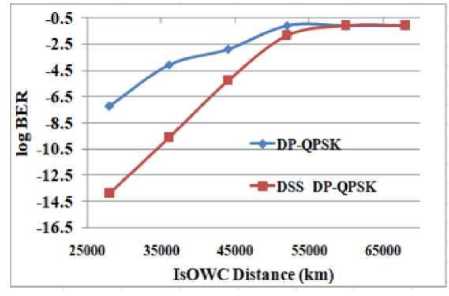
Fig.5. Performance comparisons of DP-QPSK and DSS-DP-QPSK at different distance of Is-OWC in terms of log BER
Table 1. Values of log BER at different Is-OWC distances
|
Distance (km) |
DP-QPSK |
DSS-DP-QPSK |
|
28000 |
-7.30 |
-11.09 |
|
36000 |
-4.06 |
-7.78 |
|
44000 |
-2.79 |
-3.98 |
|
52000 |
-1.25 |
-1.40 |
|
60000 |
-1.07 |
-1.06 |
|
68000 |
-1.06 |
-1.04 |
As the distance of the Is-OWC channel rises, log BER increases as wellwith the greatest value of log BER being measured at 68000 km,as shown in Fig.5. An acceptable log BER is observed at 44000 km. Because just a narrow carrier is present and sidebands are suppressed, the DSS-DP-QPSK Is-OWC system outperforms the DP-QPSK Is-OWC system in terms of spectral efficiency. Fig.6. represents the performance of implemented system in terms of EVM% at varied received power levels. EVM is a deviation of symbols from their ideal positions and decides the overall performance of the system and it is observed from the illustration that with the increase in received power, EVM% decreases as shown in Table 2.
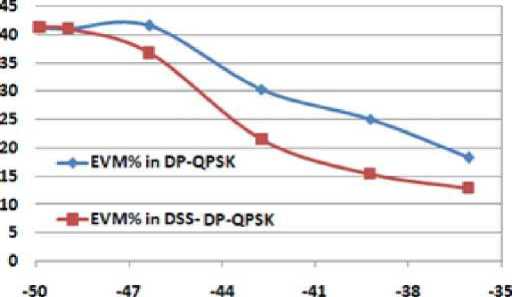
Received Power (dBm)
Fig. 6. Performance of implemented system at different received powers in terms of EVM%
Table 2. Values of EVM% at different Is-OWC received power levels
|
Received power (dB) |
EVM% in DP-QPSK |
EVM% in DSS-EC-DP-QPSK |
|
-36.4 |
28 |
15 |
|
-40.3 |
32 |
18 |
|
-43.7 |
36 |
25 |
|
-47.9 |
46 |
40 |
|
-49.5 |
49 |
41 |
|
-49.6 |
49.2 |
41.3 |
Fig. 7. displays constellation diagrams at various points in the implemented systems, such as Fig.7. (a) depicting the constellation diagram after the transmitter when no transmission line is present, also known as a back to back (B-T-B) system. All of the symbols are in their perfect positions, and the EVM is very low. Signal transmission across a transmission channel introduces various impairments such as noise, nonlinear effects, and other factors that must be compensated for. Fig.7. (b) shows a system without impairments mitigation at the receiver without utilizing DSP, and it is clear that there is a noisy symbol divergence and all the symbols are jumbled together. Fig.7. (c) depicts the symbol errors constellation when just nonlinear correction is done at DSP without any normalizing, equalization, or estimates. In addition, equalization is conducted in the DSP in Fig.7. (d), and the constellation diagram improves as compared to Fig.7. (b, c). Due to electric to optical data conversion and synchronization concerns, frequency and carrier phase noise are two key challenges in coherent optical modulations. The constellation following CPE and FOE frequency offset estimate is shown in Fig.7. (e). It has been discovered that the communication has a highly fine constellation and a very low EVM.
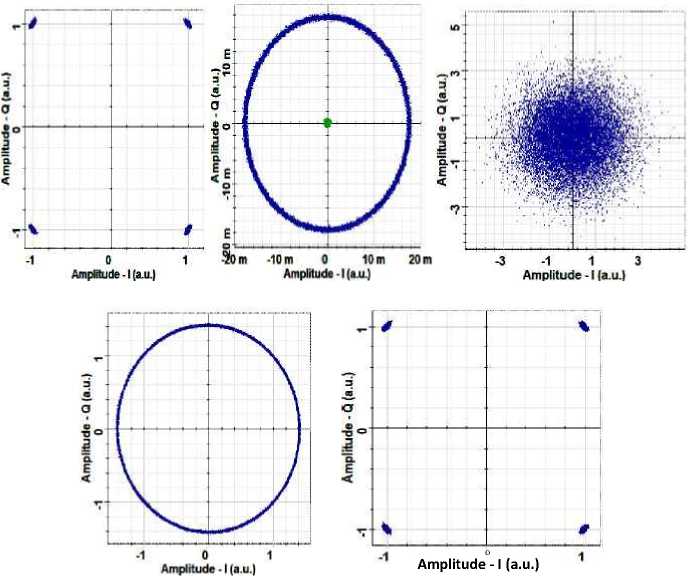
Fig. 7. Constellations of (a) B-T-B system (b) Without DSP (c) nonlinear compensation only (d) after equalization (e) after CPE and FOE
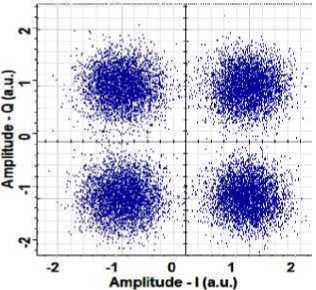
Fig.8. Constellation at 44000 km for (a) DP-QPSK (b) DSS-DP-QPSK
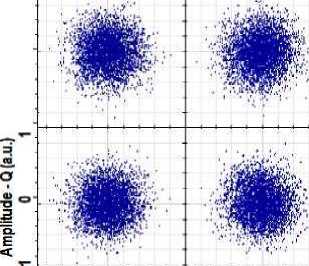
Amplitude -1 (a.u.)
The system iterated links with a distance of 44000 km, and Fig. 8. (a) displays the constellation after 44000 km for DP-QPSK and Fig. 8. (b) for DSS-DP- QPSK. Distance clearly introduces noise into the system, and even with the usage of DSP with CPE, FOE, and significant EVM are detected. However, even at 44000 km, the DSS-DP-QPSK system has an acceptable EVM range since symbols do not cross quadrants and DP-QPSK is limited to 40000 km. Table 3 shows the comparison of existing work [18] and results after DSS module in the system in terms of speed, channels, log BER, maximum distance etc.
Table 3. Comparison of existing work and proposed work
|
Parameters |
Existing Work [18] |
Proposed Work |
Percentage Improvement |
|
Data Rate |
160 Gbps |
160 Gbps |
- |
|
Modulation |
DP-QPSK |
DSS-DP-QPSK |
- |
|
Channels |
1 |
1 |
- |
|
Capacity |
160 Gbps |
160 Gbps |
- |
|
Max. Is-OWC distance achieved |
40,000 km |
44,000 km |
10% |
|
log BER |
-3 @ 40,000 km |
-4.31 @ 40000 km |
43.66% |
|
Q factor |
3.14 @ 40,000 km |
4.05 @ 40,000 km |
28.98% |
6. Conclusion
In this work, a reach enhanced single channel Is-OWC is proposed using DP- QPSK with double sidebands suppression (DSS) approach and the DSP algorithm to improve link length. Opti system modeled system successfully transmits 160 Gbps data across a 44,000 km Is-OWC transmission range with an acceptable log BER. We also look at the performance of the suggested system under the effect of various DSP scenarios. It has been discovered that having a DSP in the receiver improves performance. The results of a comparison of DP-QPSK with and without DSS indicated that DSS-DP- QPSK covers 44,000 km compared to 40,000 km in DP-QPSK. The suggested technique can be utilized to create a bandwidth-efficient high-speed long- haul Is-OWC transmission system. The performance of the suggested system can be examined further in the future employing WDM channels and spatial diversity approaches.
Список литературы Reach Enhanced Is-OWC System using Double Sideband Suppressed (DSS) DP-QPSK
- Ashwani, S.(2021). Investigation and analysis of inter-satellite- optical wireless communication system based on dense-wavelength-division multiple access. Periodicals of Engineering and Natural Sciences 9(2), 491-499.
- Singh, K., Singh, M., Malhotra, J., Grover, A.(2021). Long-Reach Cost ¬Effective 100 Gbit/S Co-OFDM-MDM-Based Inter-Satellite Optical Wireless Communication (IsOWC) System. Optoelectronics and Advanced Materials - Rapid Communications 13 (7-8), 245-253.
- Kaur, R., Kaur, H.(2018). Comparative analysis of chirped, AMI and DPSK modulation techniques in IS-OWC system. Optik 28, 755-762.
- Kaur, S., Kaur, G., Singh, G., Verma, A. (2017). Polarization Crosstalk Suppression in Wavelength Division Multiplexed Free Space Optical System Incorporating Polarization Diversity. IJCRT 5(3), 384-390.
- Kuzkov, S., Sodnik, Z., Kuzkov, V. (2013). Laser communication experiments with ARTEMIS satellite. In: 64th International Astronautical Congress (IAC), China.
- Kaur, S., Kumar, M., Verma, A. (2019). An Integrated High-Speed Full Duplex Coherent OFDM- PON and Visible-Light Communication System. J. Opt. Comm. Ahead of printing. doi/ 10.1515/joc-2018-0236.
- Singh, M., Malhotra, J. (2019). A high-speed long-haul wavelength division multiplexing-based inter-satellite optical wireless communication link using spectral-efficient 2-D orthogonal modulation scheme. International Journal of Communication Systems, doi: 10.1002/dac.4293.
- Alatwi, A. M., Rashed, A. N. Z., El-Gammal, E. M. (2020). Wavelength division multiplexing techniques based on multi transceiver in low earth orbit intersatellite systems. J. Opt. Comm. Ahead of printing. doi/10.1515/joc-2019-0171.
- Garg, N., Tripathi, A. (2019). Comparison Of Different Modulations With Proposed Hybrid WDM-TDM Inter-satellite Optical Wireless System. IREJ 2(10), 118-126.
- Gill, H. K., Walia, G. K., Grewal, N. S. (2019). Performance Analysis of Mode Division Multiplexing IS-OWC system using Manchester, DPSK and DQPSK modulation techniques. Optik 177, 93-101.
- Sodnik, Z., Furch, B., Lutz, H.(2020). Optical intersatellite communication. IEEE Journal of Selected Topics in Quantum Electronics 16(5), 1051 - 1057.
- Patnaik, B., Sahu, P. K. (2012). Inter-satellite optical wireless communication system design and Simulation. IET Communications 6, 2561-2567.
- Chaudhary, S., Sharma, A., Singh, V.(2019). Optimization of high speed and long haul inter-satellite communication link by incorporating differential phase shift key and orthogonal frequency division multiplexing scheme. Optik 176, 185-190.
- Ganga. S., Asha, R. S., Shaija, P. J. (2016). Design of a standardized Inter Satellite Optical Wireless Communication (ISOWC) system with minimum input power. In: Global Colloquium in Recent Advancement and Effectual Researches in Engineering, Science and Technology 25, pp. 567-573, Elsevier, Kerala.
- Kaue, Soni., Soni, G.(2015). Performance analysis of inter-satellite optical wireless communication (IsOWC) system by using NRZ and RZ modulation. International Journal of Scientific and Research Publications 5(1), 1-5.
- Kaur, M (2017). Design and analysis of ultra high capacity DWDM system with and without square root module for different modulation formats. IJARCS 8(5), 1714-1719.
- Gupta, A., Singh, A., Bakshi, S., Nagpal, S.(2017). Digital signal processing of 400 Gbps CO-QPSK-WDM system over optical wireless channel for Carrier Phase Estimation. Wireless Personal Communications 99, 111 - 120.
- Sivakumar, P., Singh, M., Malhotra, J., Dhasarathan, V. (2020). Performance analysis of 160gbit/s single-channel PDM-QPSK based inter-satellite Optical Wireless Communication (ISOWC) system. Wireless Networks 26, 3579-3590.
- J. B. Padhy, B. Patnaik, (2019). 100 Gbps multiplexed inter-satellite optical wireless communication system. Optical and Quantum Electronics volume, vol. 51, no. 213.
- Sharma, V., Kumar, S.(2013). Empirical evaluation of wired- and wireless¬hybrid OFDM-OSSB-ROF Transmission System. Optik 124, 4529-4532 .
- Sharma, V., Kaur, A.(2014). Modeling and simulation of long reach high speed inter-satellite link (ISL). Optik 125, 883-886.
- Kang, Z., Zhu, J.(2018). Multiband DSB-SC Modulated Radio over ISOWC link with coherent homodyne detection. In: Fourth Seminar on Novel Optoelectronic Detection Technology and Application 10697, China.
- Tickoo, S., Gupta, A(2016). A Novel Approach to Design a Bi-Directional Radio over Fiber SCM/ASK System for Future Generation Networks. Indian Journal of Science and Technology 9(36), .
- V. Kiran K, Sarth V S, V. Kumar, A.K. Turuk, S.K. Das,(2017). Performance Analysis of Inter-Satellite Optical Wireless Communication. I.J. Computer Network and Information Security, MECS, 4, 22-28.

